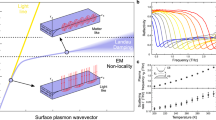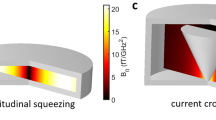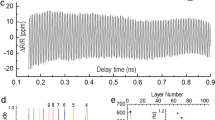Abstract
Metamaterials allow for extraordinary electromagnetic properties that are not attainable in nature1,2,3,4,5,6,7,8,9. Indefinite media with hyperbolic dispersion, in particular, have found intriguing applications10,11,12,13. The miniaturization of optical cavities increases the photon density of states and therefore enhances light–matter interactions for applications in modern optoelectronics. However, scaling down the optical cavity is limited to the diffraction limit and by the reduced quality factor. Here, we experimentally demonstrate an optical cavity made of indefinite metamaterials that confines the electromagnetic field to an extremely small space. The experiments reveal that indefinite cavities demonstrate anomalous scaling laws: cavities with different sizes can resonant at the same frequency, and a higher-order resonance mode oscillates at a lower frequency. We also demonstrate a universal fourth power law for the radiation quality factor of the wave vector. Cavities with sizes down to λ/12 are realized with ultrahigh optical indices (up to 17.4), a feature that is critically important for many applications14,15,16,17,18.
This is a preview of subscription content, access via your institution
Access options
Subscribe to this journal
Receive 12 print issues and online access
$209.00 per year
only $17.42 per issue
Buy this article
- Purchase on Springer Link
- Instant access to full article PDF
Prices may be subject to local taxes which are calculated during checkout




Similar content being viewed by others
References
Smith, D. R., Pendry, J. B. & Wiltshire, M. C. K. Metamaterials and negative refractive index. Science 305, 788–792 (2004).
Veselago, V. G. The electrodynamics of substances with simultaneously negative values of ɛ and μ. Sov. Phys. Usp. 10, 509–514 (1968).
Pendry, J. B., Holden, A. J., Robbins, D. J. & Stewart, W. J. Magnetism from conductors and enhanced nonlinear phenomena. IEEE Trans. Microw. Theory Tech. 47, 2075–2084 (1999).
Shelby, R. A., Smith, D. R. & Schultz, S. Experimental verification of a negative index of refraction. Science 292, 77–79 (2001).
Valentine, J. et al. Three-dimensional optical metamaterial with a negative refractive index. Nature 455, 376–379 (2008).
Pendry, J. B., Schrurig, D. E. & Smith, D. R. Controlling electromagnetic fields. Science 312, 1780–1782 (2006).
Schurig, D. et al. Metamaterial electromagnetic cloak at microwave frequencies. Science 314, 977–980 (2006).
Cai, W. S., Chettiar, U. K., Kildishev, A. V. & Shalaev, V. M. Optical cloaking with metamaterials. Nature Photon. 1, 224–227 (2007).
Valentine, J., Li, J. S., Zentgraf, T., Bartal, G. & Zhang, X. An optical cloak made of dielectrics. Nature Mater. 8, 568–571 (2009).
Smith, D. R. & Schurig, D. Electromagnetic wave propagation in media with indefinite permittivity and permeability tensors. Phys. Rev. Lett. 90, 077405 (2003).
Jacob, Z., Alekseyev, L. V. & Narimanov, E. Optical hyperlens: far-field imaging beyond the diffraction limit. Opt. Express 14, 8247–8256 (2006).
Salandrino, A. & Engheta, N. Far-field subdiffraction optical microscopy using metamaterial crystals: theory and simulations. Phys. Rev. B 74, 075103 (2006).
Liu, Z., Lee, H., Xiong, Y., Sun, C. & Zhang, X. Far-field optical hyperlens magnifying sub-diffraction-limited objects. Science 315, 1686 (2007).
Mansfield, S. M. & Kino, G. S. Solid immersion microscope. Appl. Phys. Lett. 57, 2615–2616 (1990).
Xiong, Y., Liu, Z. & Zhang, X. Projecting deep-subwavelength patterns from diffraction-limited masks using metal–dielectric multilayers. Appl. Phys. Lett. 93, 111116 (2008).
Shi, Z. et al. Slow-light Fourier transform interferometer. Phys. Rev. Lett. 99, 240801 (2007).
Han, S. et al. Ray optics at a deep-subwavelength scale: a transformation optics approach. Nano Lett. 8, 4243–4247 (2008).
Zentgraf, T., Liu, Y., Mikkelsen, M. H., Valentine, J. & Zhang, X. Plasmonic Luneburg and Eaton lenses. Nature Nanotech. 6, 151–155 (2011).
Spillane, S. M., Kippenberg, T. J. & Vahala, K. J. Ultralow-threshold Raman laser using a spherical dielectric microcavity. Nature 415, 621–623 (2002).
Armani, D. K., Kippenberg, T. J., Spillane, S. M. & Vahala, K. J. Ultra-high-Q toroid microcavity on a chip. Nature 421, 925–928 (2003).
Akahane, Y., Asano, T., Song, B. S. & Noda, S. High-Q photonic nanocavity in a two-dimensional photonic crystal. Nature 425, 944–947 (2003).
Vahala, K. J. Optical microcavities. Nature 424, 839–846 (2003).
Soljacic, M. & Joannopoulos, J. D. Enhancement of nonlinear effects using photonic crystals. Nature Mater. 3, 211–219 (2004).
Yoshie, T. et al. Vacuum Rabi splitting with a single quantum dot in a photonic crystal nanocavity. Nature 432, 200–203 (2004).
Kippenberg, T. J. & Vahala, K. J. Cavity optomechanics: back-action at the mesoscale. Science 321, 1172–1176 (2008).
Shen, J. T., Catrysse, P. B. & Fan, S. Mechanism for designing metallic metamaterials with a high index of refraction. Phys. Rev. Lett. 94, 197401 (2005).
Shin, J., Shen, J. T. & Fan, S. Three-dimensional metamaterials with an ultrahigh effective refractive index over a broad bandwidth. Phys. Rev. Lett. 102, 093903 (2009).
Choi, M. et al. A terahertz metamaterial with unnaturally high refractive index. Nature 470, 369–373 (2011).
Yao, J., Yang, X., Yin, X., Bartal, G. & Zhang, X. Three-dimensional nanometer scale optical cavities of indefinite medium. Proc. Natl Acad. Sci. USA 108, 11327–11331 (2011).
Manalatou, C. et al. Coupling of modes analysis of resonant channel add–drop filters. IEEE J. Quantum Electron. 35, 1322–1331 (1999).
Akahane, Y., Asano, T., Song, B. S. & Noda, S. Fine-tuned high-Q photonic-crystal nanocavity. Opt. Express 13, 1202–1214 (2005).
Englund, D., Fushman, I. & Vuckovic, J. General recipe for designing photonic crystal cavities. Opt. Express 13, 5961–5975 (2005).
Wheeler, H. A. Fundamental limitations of small antennas. Proc. IRE 35, 1479–1484 (1947).
Acknowledgements
The authors acknowledge funding support from the US Department of Energy under contract no. DE-AC02-05CH11231 through Materials Sciences Division of Lawrence Berkeley National Laboratory (LBNL). J.S.R. acknowledges a fellowship from the Samsung Scholarship Foundation, Republic of Korea.
Author information
Authors and Affiliations
Contributions
X.D.Y. and J.Y. performed numerical simulations. J.S.R. fabricated and SEM-imaged device samples. X.D.Y. carried out optical measurements. X.D.Y., X.B.Y. and X. Z. analysed the experimental data. X.D.Y., X.B.Y. and X.Z. wrote the manuscript. X.Z. and X.B.Y. guided the research. All authors contributed to discussions.
Corresponding author
Ethics declarations
Competing interests
The authors declare no competing financial interests.
Supplementary information
Supplementary information
Supplementary information (PDF 1654 kb)
Rights and permissions
About this article
Cite this article
Yang, X., Yao, J., Rho, J. et al. Experimental realization of three-dimensional indefinite cavities at the nanoscale with anomalous scaling laws. Nature Photon 6, 450–454 (2012). https://doi.org/10.1038/nphoton.2012.124
Received:
Accepted:
Published:
Issue Date:
DOI: https://doi.org/10.1038/nphoton.2012.124
This article is cited by
-
Extreme light confinement and control in low-symmetry phonon-polaritonic crystals
Nature Reviews Materials (2023)
-
From Photonic Crystals to Seismic Metamaterials: A Review via Phononic Crystals and Acoustic Metamaterials
Archives of Computational Methods in Engineering (2022)
-
Full-color enhanced second harmonic generation using rainbow trapping in ultrathin hyperbolic metamaterials
Nature Communications (2021)
-
Enhanced laser action from smart fabrics made with rollable hyperbolic metamaterials
npj Flexible Electronics (2020)
-
Fabry–Pérot modes associated with hyperbolic-like dispersion in dielectric photonic crystals and demonstration of a bending angle sensor at microwave frequencies
Scientific Reports (2020)



